Wendy Schmidt Foundation
-
- X (Prize) Marks the Spot Marine Technology, Mar 2014 #52
Wanted: Ocean pH Sensor Technology Reward: $2 Million
Nonprofit organization XPRIZE creates and manages large-scale, high-profile competitions that aim to stimulate research and development solutions to grand problems across a number of scientific fields. The group has previously held competitions targeting advances in personalized medicine, automotive fuel efficiency, oil cleanup and privatized space exploration, to name a few. For its latest competition, XPRIZE has partnered with the Wendy Schmidt Foundation to launch the $2 million Wendy Schmidt Ocean Health XPRIZE to spur global innovators to develop ocean pH sensors that it says will transform understanding of ocean acidification.
According to XPRIZE, the oceans absorb about one quarter of CO2 that humans release into the atmosphere, causing changes in water chemistry and increases in ocean acidity. “Ocean acidity is a serious threat we are only beginning to understand,” said ocean philanthropist Wendy Schmidt. “It could have significant ecological and societal implications, changing the health of entire ecosystems, affecting the global economy and the biodiversity of the planet.”
The competition’s goal is to ultimately catalyze responses to the pressing changes in ocean acidity by propelling the development of superior ocean pH sensor technology. “There are pH sensors available, but there are very few available options, many of which are too costly, imprecise and/or unstable to allow for sufficient knowledge on the state of ocean acidification,” said Paul Bunje, XPRIZE’s Senior Director of Oceans. “In particular, it has been difficult to measure pH with ease and accuracy in the coastal and deep ocean environments.”
In an effort to swiftly rectify shortcomings in current sensor technology, XPRIZE is offering $2 million in incentives (two $1 million purses: one for accuracy and the other for affordability).
Over a 22-month period, leading experts in ocean chemistry and measurement will gauge entrants’ ability to meet key factors including accuracy, precision and stability, as well as materials cost and ease of use. An independent judging panel will assign points throughout three competition trial phases: lab, coastal and sea. XPRIZE plans to announce the winners in Summer 2015.
Bunje said, “Through the prize, we aim to catalyze ocean acidification research, spur the development of the ocean services industry, inspire innovations in ocean sensing technology and stimulate the free market to meet the growing demand for ocean pH sensors by producing inexpensive, accurate and durable sensors that can be deployed on many platforms.”
And by offering large monetary incentives, XPRIZE believes breakthroughs are near, with far-reaching environmental and market results in the short and long term.
“This device would open the door to a new market of ocean services, research and data collection on a scale that does not currently exist,” Bunje said.
“If we compare this to the weather services industry for example, we are talking about a global opportunity that could develop into a billion-dollar industry. We also hope that innovative solutions will emerge that will help develop or enhance other ocean sensing technologies. XPRIZE has a lot of experience catalyzing the growth of new markets. For instance, the private space flight industry — worth more than $1.5 Billion today — did not exist before the Ansari XPRIZE.”
Bunje added, “We see this prize as the first step in unlocking the wealth of the ocean services industry. Ever-increasing amounts of data can become valuable information, including forecasting, that could be worth billions of dollars in the future, much as weather services are today. Technology has given us extraordinary progress over the last 100 years, and we believe this prize can spur the demand for data and the wealth of information latent in our oceans. When that happens, markets win and humanity wins.”
Registration for the Wendy Schmidt Ocean Health XPRIZE is open now through June 30, 2014. Entry fees are $1,000 per team until March 31, and $2,500 from April 1.
Teams are expected to come from diverse backgrounds, ranging from nanotechnology and biotechnology to industrial chemistry and marine science – from academic institutions, nonprofit organizations and small and medium enterprises – but XPRIZE said anyone with a creative idea to revolutionize ocean pH sensor technology is encouraged to compete. More information is available at xprize.org.Quick Facts
What: Wendy Schmidt Ocean Health XPRIZE
Prize pool: $2m
Deadline: June 30, 2014
Entry fee: $1,000 per team until March 31
$2,500 from April 1
Web: www.xprize.org(As published in the March 2014 edition of Marine Technology Reporter - www.seadiscovery.com)
-
 )
March 2024 - Marine Technology Reporter page: 41
)
March 2024 - Marine Technology Reporter page: 41Image courtesy Outland Technology Image courtesy Exail Image courtesy Submaris and EvoLogics Vehicles The ROV-1500 from Outland Technology represents a leap forward in underwater robotics, a compact remotely operated vehicle (ROV) weighing in at less than 40 lbs (19kg) the ROV- 1500 is easy to transport
-
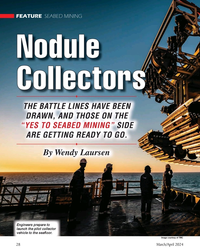 )
March 2024 - Marine Technology Reporter page: 28
)
March 2024 - Marine Technology Reporter page: 28FEATURE SEABED MINING Nodule Collectors THE BATTLE LINES HAVE BEEN DRAWN, AND THOSE ON THE “YES TO SEABED MINING” SIDE ARE GETTING READY TO GO. By Wendy Laursen Engineers prepare to launch the pilot collector vehicle to the sea? oor. Image courtesy of TMC 28 March/April 2024 MTR #3 (18-33).indd
-
 )
March 2024 - Marine Technology Reporter page: 25
)
March 2024 - Marine Technology Reporter page: 25Auerbach explained that ideally, “one ? ed layers of geothermal activity,” noted changes over an area of 8,000 km2. They would have both instruments: seismom- Skett, “and the change in salinity and dis- found up to seven km3 of displaced ma- eters to detect and locate subsurface ac- solved particles for
-
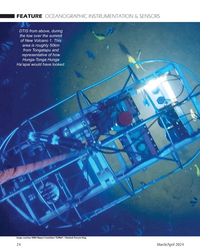 )
March 2024 - Marine Technology Reporter page: 24
)
March 2024 - Marine Technology Reporter page: 24FEATURE OCEANOGRAPHIC INSTRUMENTATION & SENSORS DTIS from above, during the tow over the summit of New Volcano 1. This area is roughly 50km from Tongatapu and representative of how Hunga-Tonga Hunga Ha’apai would have looked. Image courtesy NIWA-Nippon Foundation TESMaP / Rebekah Parsons-King 24
-
 )
March 2024 - Marine Technology Reporter page: 22
)
March 2024 - Marine Technology Reporter page: 22FEATURE OCEANOGRAPHIC INSTRUMENTATION & SENSORS Aerial view of HT-HH volcano, showing new multibeam depth data overlaid on islands satellite image. © SEA-KIT, NIWA-Nippon Foundation TESMaP 22 March/April 2024 MTR #3 (18-33).indd 22 4/4/2024 9:08:10 AM
-
 )
March 2024 - Marine Technology Reporter page: 6
)
March 2024 - Marine Technology Reporter page: 6study abroad experience in France and Ecuador. Currently, she is pursuing her master of environmental studies degree at Dalhousie University. Laursen Wendy Laursen has 20+ years of experience as a journalist. In that time, she has written news and features for a range of maritime, engineering and science
-
 )
March 2024 - Marine Technology Reporter page: 4
)
March 2024 - Marine Technology Reporter page: 4Editorial NIWA-Nippon Foundation TESMaP/ Rebekah Parsons-King www.marinetechnologynews.com ast month marked the resounding NEW YORK 118 E. 25th St., New York, NY 10010 return of Oceanology Interna- Tel: (212) 477-6700; Fax: (212) 254-6271 tional in London, perennially one Lof the world’s most important
-
 )
March 2024 - Marine Technology Reporter page: 2
)
March 2024 - Marine Technology Reporter page: 2Ha’apai Eruption By Celia Konowe Subsea Mining 28 Nodule Collectors Tapping the sea ? oor for resources may be controversial, but it’s happening. y Wendy Laursen B 34 Lander Lab We Need More Power Stored electrical power in batteries permit the untethered operation of sea? oor instrumentation
-
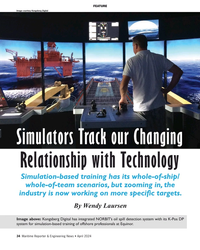 )
April 2024 - Maritime Reporter and Engineering News page: 34
)
April 2024 - Maritime Reporter and Engineering News page: 34training has its whole-of-ship/ whole-of-team scenarios, but zooming in, the industry is now working on more speci? c targets. By Wendy Laursen Image above: Kongsberg Digital has integrated NORBIT’s oil spill detection system with its K-Pos DP system for simulation-based training of
-
 )
April 2024 - Maritime Reporter and Engineering News page: 32
)
April 2024 - Maritime Reporter and Engineering News page: 32FEATURE A closeup of a blade installation process taken via drone. A blade handling system is apparent (in yellow). Images courtesy of Mammoet requirement for the development of these cranes, particularly ling area. This would result in a major time and fuel saving. in ? oating offshore wind,” says
-
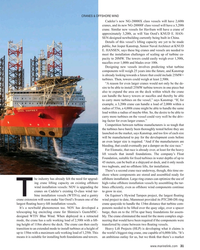 )
April 2024 - Maritime Reporter and Engineering News page: 31
)
April 2024 - Maritime Reporter and Engineering News page: 31CRANES & OFFSHORE WIND Cadeler’s new NG-20000X class vessels will have 2,600t cranes, and its new NG-20000F class vessel will have a 3,200t crane. Similar new vessels for Havfram will have a crane of approximately 3,200t, as will Van Oord’s KNUD E. HAN- SEN-designed newbuilding currently being built in
-
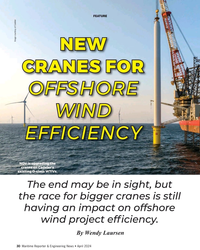 )
April 2024 - Maritime Reporter and Engineering News page: 30
)
April 2024 - Maritime Reporter and Engineering News page: 30existing O-class WTIVs. The end may be in sight, but the race for bigger cranes is still having an impact on offshore wind project ef? ciency. By Wendy Laursen 30 Maritime Reporter & Engineering News • April 2024 MR #4 (18-33).indd 30 4/5/2024 8:27:59 A
-
 )
April 2024 - Maritime Reporter and Engineering News page: 14
)
April 2024 - Maritime Reporter and Engineering News page: 14Book Review Approach to Meeting Underwater Radiated Noise Limits Def ned By Raymond Fischer uantitative underwater radiated noise limits will construction inspections, 5) possible training with respect to be developed shortly by IMO, and/or countries salient design/construction essentials, 6) compliance
-
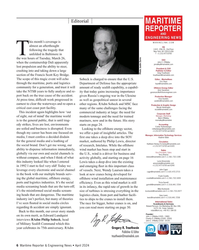 )
April 2024 - Maritime Reporter and Engineering News page: 6
)
April 2024 - Maritime Reporter and Engineering News page: 6to feel very old! Today we and emerging ? eet in this important class John Cagni leverage every electronic and social channel of vessels. Next, Wendy Laursen takes a [email protected] | +1.631.472.2715 in the book with our multiple brands serv- look at new cranes being developed for Frank Covella
-
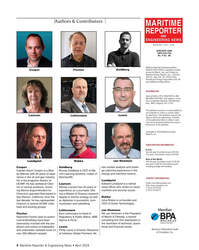 )
April 2024 - Maritime Reporter and Engineering News page: 4
)
April 2024 - Maritime Reporter and Engineering News page: 4[email protected] OCIMF. He has worked at Chev- Laursen Edward Lundquist is a retired Web: www.marinelink.com ron in various positions, includ- Wendy Laursen has 20 years of naval of? cer who writes on naval, t: (212) 477-6700 f: (212) 254-6271 ing Marine Superintendent for experience as a journalist
-
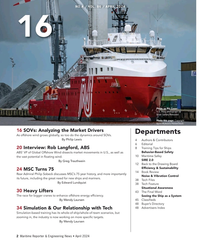 )
April 2024 - Maritime Reporter and Engineering News page: 2
)
April 2024 - Maritime Reporter and Engineering News page: 2Awareness 30 Heavy Lifters 43 The Final Word The race for bigger cranes to enhance offshore energy ef? ciency. Seeing the Ship as a System By Wendy Laursen 45 Classi? eds 48 Buyer’s Directory 48 Advertisers Index 34 Simulation & Our Relationship with Tech Simulation-based training has its whole-of-ship
-
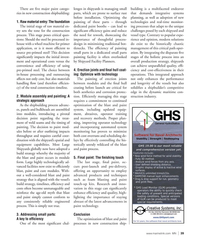 )
April 2024 - Marine News page: 39
)
April 2024 - Marine News page: 39There are ? ve major paint catego- lenges in shipyards is managing small building is a multifaceted endeavor ries in new construction shipbuilding: parts, which are prone to surface rust that demands integrative systems before installation. Optimizing the planning, as well as adoption of new 1.
-
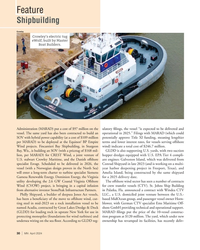 )
April 2024 - Marine News page: 30
)
April 2024 - Marine News page: 30Feature Shipbuilding Crowley Crowley’s electric tug eWolf, built by Master Boat Builders. Administration (MARAD) put a cost of $97 million on the ulatory ? lings, the vessel “is expected to be delivered and vessel. The same yard has also been contracted to build an operational in 2025.” Filings with
-
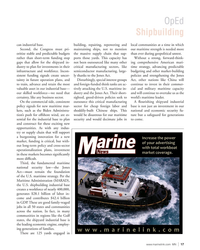 )
April 2024 - Marine News page: 17
)
April 2024 - Marine News page: 17OpEd Shipbuilding can industrial base. building, repairing, repowering and local communities at a time in which Second, the Congress must pri- maintaining ships, not to mention our maritime strength is needed more oritize stable and predictable budgets the massive supply chain that sup- than ever
-
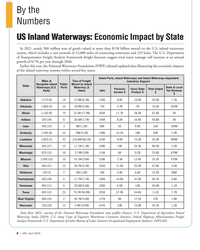 )
April 2024 - Marine News page: 8
)
April 2024 - Marine News page: 8By the Numbers US Inland Waterways: Economic Impact by State In 2021, nearly 500 million tons of goods valued at more than $158 billion moved on the U.S. inland waterways system, which includes a vast network of 12,000 miles of connecting waterways and 219 locks. The U.S. Department of Transportation
-
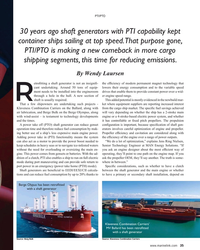 )
February 2024 - Maritime Reporter and Engineering News page: 35
)
February 2024 - Maritime Reporter and Engineering News page: 35ships sailing at top speed. That purpose gone, PTI/PTO is making a new comeback in more cargo shipping segments, this time for reducing emissions. By Wendy Laursen etro? tting a shaft generator is not an insigni? - the ef? ciency of modern permanent magnet technology that cant undertaking. Around 50
-
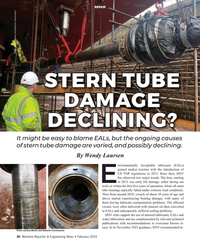 )
February 2024 - Maritime Reporter and Engineering News page: 30
)
February 2024 - Maritime Reporter and Engineering News page: 30TUBE DAMAGE DECLINING? It might be easy to blame EALs, but the ongoing causes of stern tube damage are varied, and possibly declining. By Wendy Laursen nvironmentally Acceptable lubricants (EALs) gained market traction with the introduction of US VGP regulations in 2013. Since then, DNV has
-
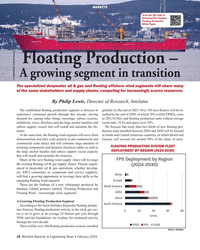 )
February 2024 - Maritime Reporter and Engineering News page: 18
)
February 2024 - Maritime Reporter and Engineering News page: 18MARKETS Scan the QR Code to Download the Intelatus Floating Production White Paper. Floating Production – A growing segment in transition © AdobeStock_Dolores Harvey The specialized deepwater oil & gas and ? oating offshore wind segments will share many of the same stakeholders and supply chains
-
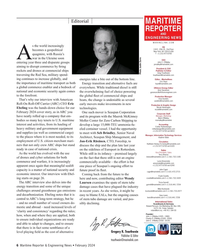 )
February 2024 - Maritime Reporter and Engineering News page: 6
)
February 2024 - Maritime Reporter and Engineering News page: 6Ebel- Coming back from the future to the Frank Covella [email protected] | +1.561.732.1659 ing starts on page 26. here and now, contributing editor Wendy Tricia Garrett The ARC interview also delves into the Laursen examines the spate of stern tube [email protected] | +1.516.441.7254 energy
